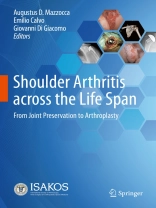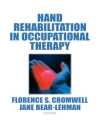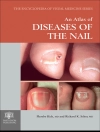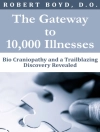This book comprehensively covers the diagnosis, classification, assessment, and management of shoulder arthritis, a condition with increasing incidence that affects people of all ages. In a multidisciplinary format, it discusses imaging, laboratory testing, nutrition, surgery and rehabilitation.
The first part of the book covers conservative treatments, followed by various minimally invasive treatments and specific techniques in the second part. The subsequent parts of the book focus on joint replacement, including alternative options to traditional arthroplasty. Each part is further divided by age group, addressing specific considerations unique to each population. The final part explores new technologies applied to shoulder arthroplasty.
Published in collaboration with ISAKOS, this book provides a thorough discussion on how to prevent failure, diagnose, and manage shoulder arthritis in patients of all ages. Written by leading international shoulder experts, it is an essential resource for shoulder surgeons, rehabilitators, and other healthcare practitioners.
विषयसूची
Part I. Joint Preservation: Conservative Non-operative treatment.- 1. Physical Therapy and exercise to increase ROM and Decrease pain.- 2. Corticosteroids, NSAIDS, vitamins, naturopathic remedies that can help shoulder arthritis.- 3. Biologics in the treatment of cartilage lesions.- 4. Non operative Management of Shoulder Arthritis in the Athlete.- Part II. Joint Preservation: Arthroscopic Management.- 5. Arthroscopic management: capsular release, chondroplasty, and debridement.- 6. Comprehensive Arthroscopic Management (CAM) procedure.- 7. Microfracture for lesions on the Glenoid and Humerus.- 8. Fresh Osteochondral Allograft Transplantation in the Shoulder.- 9. Autologous Cartilage Implantation (ACI) for lesions on the Glenoid and Humerus.- 10. Dislocation Arthropathy- Shoulder Arthritis after Bankart Repair.- Part III. Joint Replacement:Open Treatment Young patient.- 11. Total resurfacing in young patients and Partial-Resurfacing of the humeral head.- 12. Hemiarthroplasty in the young patient. Post traumatic AVN and Malunion .- 13. Alternatives to glenoid prosthesis in young patients (Grafts, ream and run, ect) – Arthrocopic Glenoid Resurfacing for treatment of s.- 14. Long, short stem or stemless humeral component?.- 15. Total Shoulder Arthroplasty in young athletic patient.- Part IV. Joint Replacement: Open Treatment in Middle-aged.- 16. Long term TSA Surgical Outcomes at 10-20 years. Postoperative results from the Australian and US registries.- 17. Long term RTSA Surgical Outcomes.- 18. Strategies to improve function in RTSA: Glenoid-shaft angle and lateralization in TSA.- 19. Glenoid types and fixation systems in TSA.- 20. TSA and subscapularis repair and failure.- 21. TSA in a patient with Rotator Cuff tear.- 22. Shoulder arthroplasty and inflammatory arthritis.- 23. Shoulder arthroplasty and Infection.- 24. Shoulder arthroplasty and instability.- 25. TSA in a middle aged and elderly patient.- 26. RSA in a middleaged patient.- 27. RSA after failed RCR or SCR.- 28. Management of bone deficiency in shoulder arthroplasty.- 29. Post op rehab and return to play after shoulder arthroplasty.- 30. Management of TSA and RSA complications: Tips and Tricks to avoid them.- Part V. Joint Replacement: Open Treatment in Elderly.- 31. RSA in a Patient with an Intact Rotator Cuff.- 32. Anatomic TSA in Elderly Patient – Concerns and advantages.-33. Revision shoulder arthroplasty.- 34. Infection with bone loss including antibiotic spacer info.-35. Periprosthetic fractures in TSA.- 36. Tendon transfers and Shoulder Arthroplasty.- 37. Influence of biomechanics on RSA and it’s implication in surgical decision making process.- Part VI. New technologies in shoulder arthroplasty.- 38. Arthroscopy and shoulder arthroplasty.- 39. Preoperative planning in TSA.- 40. Robotic surgery in shoulder arthroplasty.- 41. Subscapularis Preserving Approaches to Shoulder Replacement in the Young Athletics Patient.
लेखक के बारे में
Emilio Calvo is the Director of the Shoulder and Elbow Reconstructive Surgery Unit and Professor of Orthopedics at the Department of Orthopedic Surgery of at Fundacion Jimenez Diaz, a teaching hospital affiliated with the Autonomous University of Madrid. He is an active member of national and international scientific societies, like the European Society for Surgery of the Shoulder and Elbow (ESSSE), the American Shoulder and Elbow Surgeons (ASES), the European Society for Sports and Knee Arthroscopy (ESSKA), and the International Society of Arthroscopy, Knee Surgery and Orthopedic Sports Medicine (ISAKOS). He has served as a member of the ESSSE Program Committee and the ISAKOS Upper Extremity Committee.
Giovanni Di Giacomo is the Head of the Orthopedics and Traumatology department at the Concordia Hospital in Rome (ISAKOS Teaching Center). He has been European Chairman of STMS (Society for Tennis Medicine and Science) since 2016, and since 2022 he is the President of the Italian Society of Knee, Arthroscopy, Sports, Cartilage, Orthopedic Technologies (SIAGASCOT). Dr. Di Giacomo is also a member of many other prestigious scientific societies, as AAOS (American Academy of Orthopedic Surgeons), Upper Extremity Committee of ISAKOS (International Society of Arthroscopy, Knee Surgery and Orthopedic Sports Medicine).
Augustus D. Mazzocca is a Professor at the Department of Orthopedic Surgery at UConn Health. He is the Director of the Orthopedic Bioskills Laboratory, and Director of Resident Education for the Department of Orthopedic Surgery. He is also an active team physician for the UConn athletic teams. He specializes in the management of shoulder and elbow problems. He is a member of the prestigious American Shoulder and Elbow Surgeons Society, as well as being a member of the European Society for Surgery of the Shoulder and Elbow. He is a co-founder of the New England Shoulder and Elbow Society.












